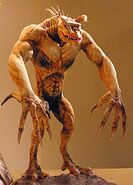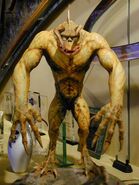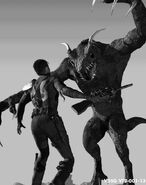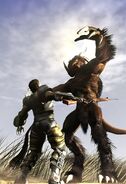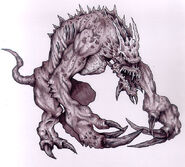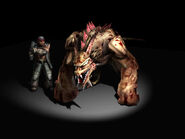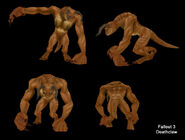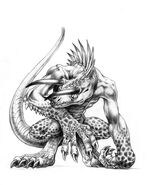| Line 7: | Line 7: | ||
==Varieties== |
==Varieties== |
||
| − | Outside of the two versions described below, there are at least two variations of the 'regular' deathclaw. One has a spiked back and long, forward horns, while the other has no spikes on the back and has smaller, backward horns. It is possible that the former deathclaws are male while the latter are female.{{Ref|3}} |
+ | Outside of the two versions described below, there are at least two variations of the 'regular' deathclaw. One has a spiked back and long, forward horns, while the other has no spikes on the back and has smaller, backward horns. It is possible that the former deathclaws are male while the latter are female.{{Ref|3}}. |
===Talking deathclaws=== |
===Talking deathclaws=== |
||
Revision as of 14:24, 9 May 2007
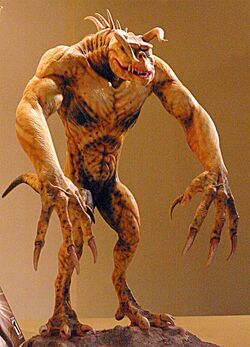
Original deathclaw clay model
Deathclaws are an enormously large, agile, and strong species of genetically engineered reptiles. They are substantially larger than a human, and have large and dangerous claws. It is claimed that they were originally derived from mixed animal stock DNA (mostly Jackson's Chameleons)1 before the Great War to replace humans during close-combat search-and-destroy missions and later refined by the Master, using genetic manipulation2, but the accounts of their origins vary.
Female deathclaws, also called Mothers and Matriarchs, are stronger and tougher than males, as well as fewer in numbers. Only one female is the pack mother at a given time, with another female taking its place when it dies. A pack is led by an 'alpha male'. Although they do not have vocal chords, the deathclaws seem to be able mimic human speech much the same as a parrot does, although normal deathclaws aren't intelligent enough to be capable of real speech.
Around 2161, deathclaws were still a mystery, a legendary creature, to many inhabitants of Southern California. In Fallout, a deathclaw first appeared in a mission to find missing caravans: while the deathclaw was not responsible for the caravan disappearances, as some had believed, evidence in its lair did lead to the correct solution. Deathclaws had also established a nest in the abandoned warehouse district of the Boneyard, obstructing traffic between the Gun Runners and potential trading partners and making any scavenging in the area very hazardous. As the deathclaw population grew, the deathclaws stopped being perceived as legendary beasts, and started to be seen as simply yet another dangerous animal.
Varieties
Outside of the two versions described below, there are at least two variations of the 'regular' deathclaw. One has a spiked back and long, forward horns, while the other has no spikes on the back and has smaller, backward horns. It is possible that the former deathclaws are male while the latter are female.3.
Talking deathclaws
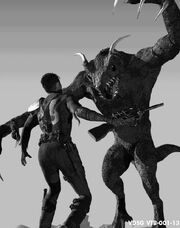
Deathclaw art from Fallout 1
In 2235, the Enclave captured many deathclaws and exposed them to FEV. This boosted their intelligence, giving them the ability to talk with varying degrees of erudition and articulation. This subspecies was highly intelligent, about the equivalent of an eight-year-old, with some individuals reaching human normal level. Their learning capacity was very high and they were capable of abstract thought and reasoning. Although they did not have vocal chords, the deathclaws seemed to mimic human speech the same as a parrot does. Socially, they had a very rigid code of ethics. They were extremely loyal to the pack as a whole, treating it as a family unit rather than having individual families.1.
While the Enclave hoped that the Deathclaws would be intelligent enough to obey orders without being so intelligent as to question them, the Enclave's deathclaws began to doubt the morality of their masters. While they helped the Enclave in storming Vault 13 in 2242 and kidnapping the population, they later abandoned the Enclave, adopting the now-empty vault as their new home under the leadership of Gruthar.
Several humans from the surrounding area moved into the vault to live under the protection of the deathclaws, but not all were pleased with these new neighbors. One human, Matt, struck against the deathclaws by bombing the mother and hatchlings (the deathclaw mother survived, but security was tightened from then on). The deathclaws faced other problems adapting to life in the vault, as well: after the overthrow of the paranoid Overseer, the dwellers of Vault 13 had turned day-to-day operations of the vault over to a Brotherhood-technology based computer. The only way the deathclaws could interact with it was by voice commands, but the computer's voice module was broken. Fortunately, a travelling tribal known as the Chosen One had a replacement voice module, and was willing to install his in exchange for Gruthar's help in finding a GECK, one of which Gruthar had within the vault's storage area.
The deathclaws paid a high price for their rebellion, however: an Enclave team, lead by Frank Horrigan, attacked Vault 13 and massacred the deathclaws (and presumably those humans under their protection). Of Vault 13's inhabitants, only Goris, who had accompanied the Chosen One on adventures outside Vault 13, survived.
Depending on the actions of the Chosen One, Xarn, a deathclaw kept in Navarro under the custody of Doctor Schreber, and Goris were the only intelligent deathclaws in the whole Fallout Canon to survive the end of Fallout 2. They did not, however, reproduce, and were the last of their kind.4
Intelligent Deathclaws have a rigidly hierarchical, peaceful, pack-based ethical code. Fights within a pack are unheard of, and the pack's leader controls many aspects of life, such as choosing and matching female and male deathclaws for reproduction.
Hairy deathclaws
Template:Tactics
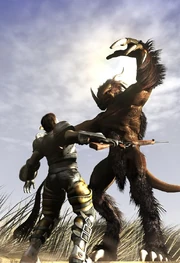
One of the infamous hairy deathclaws from Fallout Tactics
A deathclaw subspecies living in the area of the former states of Illinois, Missouri and Kansas developed patches of fur to better cope with the colder climate. Furthermore, some of them were noted to be capable of speech as early as in 2197, which means that they either developed speech through spontaneous mutation, or were experimented on by someone other than the Enclave. It is also possible that they were a different species altogether, called "deathclaws" by the Brotherhood only because of their similarities to the ferocious reptiles from the West. They were also more matriarchal than their Western counterparts, with packs being led by Matriarchs.
One such Matriarch was captured by the psychic tribe known as the Beastlords. While the tribals were able to use their psychic powers to control lesser animals, the deathclaws were intelligent enough to resist them. However, they cooperated with the Beastlords in order to protect their Mother. After the Matriarch was freed by the Eastern Brotherhood of Steel, that pack decided to join the Brotherhood, and the Elders surprisingly agreed.
Quotes
- "The Deathclaw is the most evil thing to rise out of the ashes after the War. Some say it's a powerful ghost from the war that haunts the land. It's no ghost, it's as real as you and me. It's 20 feet tall with teeth as big as your arm. It's some kind of demon that found it's way here when the world was engulfed in fire." - Beth (Beth's dialogue file)
- "The Deathclaws are all over in the Boneyard. I'd rather not even think about them. Huge and aptly named." - Katja (Katja's dialogue file)
- "Okay. Well, it's like a damn big man, is what it is. Got spikes and claws that can cut through the heaviest armor. But don't let the size fool ya, it's quick." - Harold (Harold's dialogue file)
- "You can't look at 'em! It is said the Death Claw can hypnotize just by lookin'. Then it walks up and "boom", you're et!" - Harold (Harold's dialogue file)
- "Heard some tales about something faster, bigger, and meaner than any living creature has a right to be. Not too many, though, which means that it doesn't leave many survivors. Big claws, ferocious disposition." - Tycho (Tycho's dialogue file)
- "The Death Claw? Oh, that's a bedtime story. Drinks blood and howls at the full moon." - Killian Darkwater (Killian's dialogue file)
- "I heard a tale from a traveller up from the south. He said the Death Claw was a creature that killed people at night. He said no one can catch it, because it can disappear like smoke. Not that I believe it, of course." - Tandi (Tandi's dialogue file)
Gallery
Fallout and Fallout 2
Fallout Tactics
Fallout: Brotherhood of Steel
Van Buren
Fallout d20
Appearances in games
Deathclaws appear in all Fallout games. In Fallout Tactics hairy, talking deathclaws appeared. As their existence is inconsistant with facts established in the previous games, they are not considered to be canon.
Behind the scenes
In Scott Campbell's original concept art (see: gallery), deathclaws were mammals covered with fur. However, after a Dungeons & Dragons computer game made by Interplay was cancelled, deathclaws were modelled (visually) on the Tarrasques of the D&D canon, as a Tarrasque clay model was already made.
Notes
^ 1 Joseph (Ocjoseph.msg) in Fallout 2 says (about the talking deathclaws):
- Well, let's see... Deathclaws appear to be mutated Jackson's Chameleons, the horned variety. There are a lot of similarities still present, but an even greater number of differences. The mutation factor is quite high. This species is highly intelligent, about the equivalent of an eight-year-old, with some individuals reaching human normal level. Their learning capacity is very high and they are capable of abstract thought and reasoning.
^ 2 Deathclaws being genetically engineered before the War and later refined by the Master is mentioned only in the Fallout 2 Official Strategies & Secrets strategy guide, written by Fallout 2 lead designer, Matt Norton and is not considered canon by some fans. It is unknown why the Master would genetically manipulate the Deathclaws and then not use them at all for his purposes.
^ 3 The version with forward horns and (sometimes) spikes is the one from the clay model and the in-game model in Fallout, Fallout 2 and Van Buren. The other version is seen in one of the images in the Fallout manual.
^ 4 The Fallout Bible is mixed as to whether Xarn and Goris could reproduce and save the intelligent deathclaw breed, but the most recent and authoritative entries claim not. In a March 11th, 2002 update, John Deiley wrote:
- In any case, there is a chance that two intelligent deathclaws survived to continue on the species. I realize that they are both males, but that is fine. When they were engineered by the Enclave, the intelligence gene was made male specific and dominant. What this means is: Any intelligent male that mated with a non-intelligent female would (most likely) produce intelligent offspring.
However, in a later, July 10th, 2002 update of the Fallout Bible, Chris Avellone denied that the intelligent deathclaws lived, writing:
- BTW, the talking deathclaws were destroyed at the end of Fallout 2. Xarn and Goris did not go on to create a new species. They are gone. Kaput. Goodbye. In fact, any mutant animal that talks can safely be assumed to have died at the end at the exact minute that Fallout 2 was over.
- Any last words, talking animals?
- I thought not.

